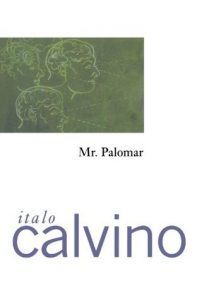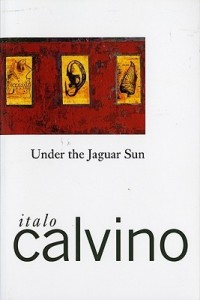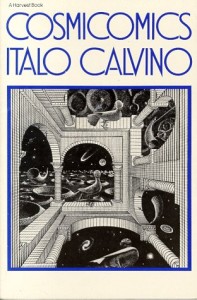 I always think I like Italo Calvino because his sentences are as clean as his ideas are wildly creative. I know he was at least as interested in the form of writing and the semiotics of text as I am and I like Calvino so much that I own every one of his books that was ever translated into English (plus a few that weren’t). But that wasn’t where I was when I picked up Mr. Palomar on a recent winter’s night. I didn’t need my mind blown like it was with Invisible Cities and I didn’t need to re-imagine narrative like I did when reading If on a Winter’s Night a Traveler. I wanted clean enough writing that I could get something out of it in the few pages before I passed out—something that would subconsciously help me clarify my own thoughts and sentences.
I always think I like Italo Calvino because his sentences are as clean as his ideas are wildly creative. I know he was at least as interested in the form of writing and the semiotics of text as I am and I like Calvino so much that I own every one of his books that was ever translated into English (plus a few that weren’t). But that wasn’t where I was when I picked up Mr. Palomar on a recent winter’s night. I didn’t need my mind blown like it was with Invisible Cities and I didn’t need to re-imagine narrative like I did when reading If on a Winter’s Night a Traveler. I wanted clean enough writing that I could get something out of it in the few pages before I passed out—something that would subconsciously help me clarify my own thoughts and sentences.
Books. They always seem to give me what I need instead of what I thought I wanted. Maybe that’s why I love them so much.
Reading a Wave: The Subtlety of Form
“The sea is barely wrinkled, and little waves strike the sandy shore. Mr. Palomar is standing on the shore, looking at a wave. Not that he is lost in contemplation of the waves. He is not lost, because he is quite aware of what he is doing: he wants to look at a wave and he is looking at it. He is not contemplating, because for contemplation you need the right temperament, the right mood, and the right combination of exterior circumstances” – Italo Calvino, Mr. Palomar
In these first few lines of “Mr. Palomar’s Vacation,” I was entranced as Calvino describes the ocean. I thought it was because I, too love watching the ocean and reading the waves. I thought it was because Calvino captured the ambivalence I sometimes feel when I’m trying to settle into a meditative activity like watching the sea or reading a book.
I think I was two pages into the story when I realized what should have been obvious from just what I quoted above. The story is a wave. Mr. Palomar laps his attention out to the sea and then pulls it back inward to experience his own fluttery anxiety. This happens again as Calvino pours all his writerly attention into the next incoming wave and then pulls back again to examine more closely Mr. Palomar’s interior state.
In the few pages that make up this story, Calvino pushes us out into the sea and pulls us back over and over. What might sound like an exhausting activity is actually a transcendent experience. As is the case with actually watching the ocean, the reader experiences a fractal-like delving into the two characters here: the ocean and Mr. Palomar where with each paragraph we see more clearly the details of both.
Calvino can do this because his language is so clean. If the story had been laden with adjectives, I might have missed the underlying form entirely and instead been mildly bored by a scene where not much ever happens except a neverending push-pull between man and nature where neither progresses much.
Instead, I sat up in bed and started rummaging for a pen to annotate this marvelous book. I needed to understand how Calvino was doing so subtly something I’ve only managed to clumsily muddle through as I divide pages in twos, threes, and fours to show the movement of energy through a poem or reconsider the shape of a text and accompanying imagery to convey a larger story than is evident from the words on the page. I’m not sorry I’m making big moves like that in my own work because I think I need to in order to understand the shape of things for myself. But I do hope I someday come close to the subtle mastery of making a paragraph that is a wave, rather than simply looking like one.
The Index: Reconsidering an Entire Work
Why might a 126-page book need an index? That was my thought, anyway, when Mr. Palomar flopped open to its back pages a few nights later to show me what else I’d been missing. Because I was only reading a fragment or two a night, I hadn’t yet registered that these tiny scenes were thematically organized. It turns out each chapter is contemplated in turn from a visual, anthropological, and then speculative angle.
To be honest, now that I’ve had time to contemplate this form a little, I’m not sure it’s necessary for this read of the book. The stories are rich and interesting enough in their own ways without being part of this larger design, but I love that it’s there for future, deeper reads as I hone my own mastery of form.
What is it About Form, Anyway?
As I plod through my own experiments with form, I feel a bit sometimes like I’m creating this narrowly-defined reading experience for an audience who might otherwise miss the subtleties of what I want to say. Calvino shows me, though, that in the hands of a master, form can be an overlay (or an underlayment) to a story. Though it sets up the conditions of the story, its existence can be as ignorable as the shapes of the pipes in the walls of a home.
The true beauty of form, though, is when it gives shape and context to a story in the way that religion or philosophy give shape and context to life. We can exist without them, but there’s something very comforting about believing that each crashing wave is part of the pattern of our existence. Maybe that’s the real reason I picked up Mr. Palomar, because Calvino always gives me the comfort of believing in a greater design.
If you want to explore the world according to Calvino, pick up a copy of Mr. Palomar from Powell’s Books. Your purchase keeps indie booksellers in business and I receive a commission.

 As I was reading Cosmicomics by Italo Calvino this weekend, I felt like the story “The Distance of the Moon” was somehow familiar. I had seen it—with my eyes, not in my imagination. But it wasn’t quite the same story. It took a few hours for me to remember that I was thinking of Pixar’s La Luna, the short film at the front of Brave.
As I was reading Cosmicomics by Italo Calvino this weekend, I felt like the story “The Distance of the Moon” was somehow familiar. I had seen it—with my eyes, not in my imagination. But it wasn’t quite the same story. It took a few hours for me to remember that I was thinking of Pixar’s La Luna, the short film at the front of Brave.